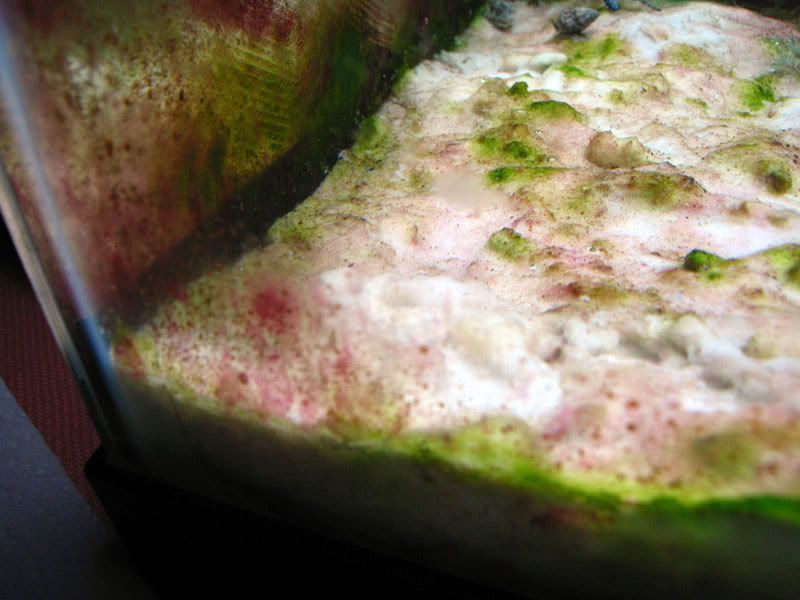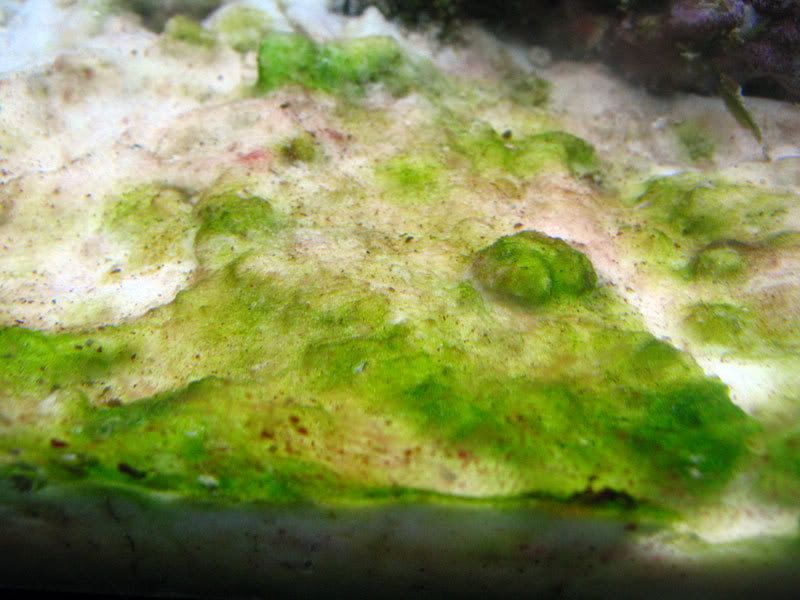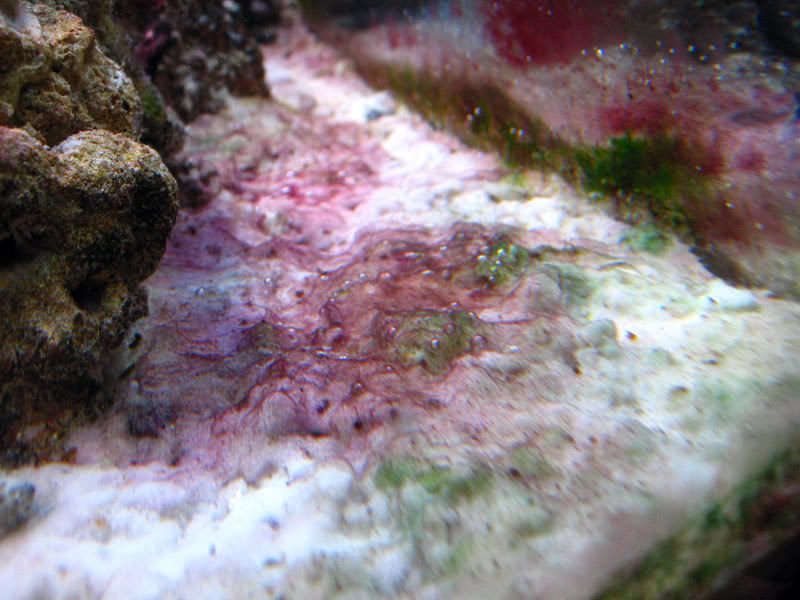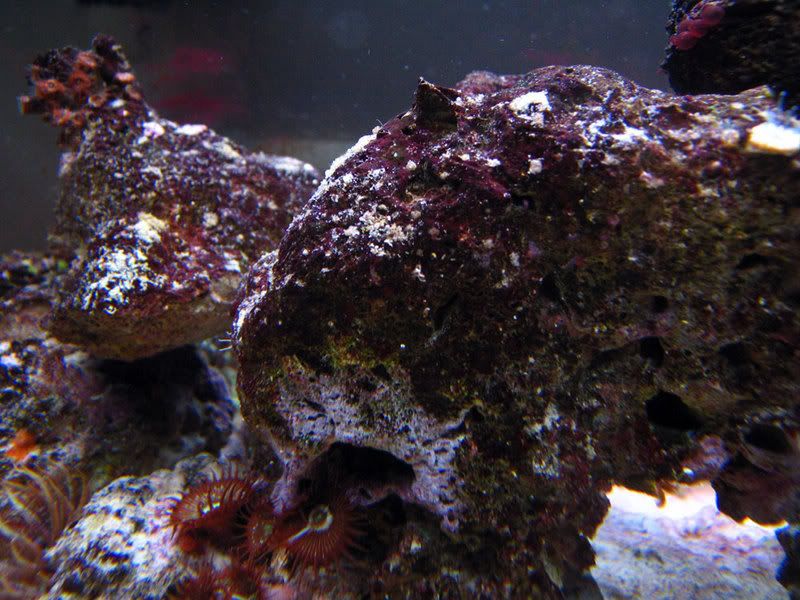That is cyanobacteria, aka blue-green algae, and usually is a definite sign of high phosphates and/or low water flow. It CAN however be fueled by high nitrates, or high levels of DOCs. (dissolved organic carbons)
From Bob Fenner at WetWebFotos:
WetWebFotos.com - Article/FAQ
""I don’t want them", "Where’d they come from?":
Sources of BGA’s are many… live rock, water from livestock introductions, foods, even "just" the air can supply sufficient spore material to get your tank going… Face it, given conditions and the absence of other competing life forms that DON’T favor BGA, they will occur, proliferate. What are these conditions? Read on:
Environmental Conditions Favoring BGA
Habitat
The following generalizations are, of a necessity, just that. As a rule BGA are attached forms that cover, loosely or not, rock, substrates, other living things, though there are some free floating forms that can be responsible for "green water" conditions.
Chemical/Physical
As you might guess, these "winning" life forms (they’ve been here much longer than most everything else) display tremendous environmental range and tolerance to change. Including such parameters as higher and lower pH's than "higher" forms of life (that do well mainly between 8.0-8.3); stable temperatures (in the low 70's to low 80's); ditto for specific gravity (1.023-1.025). BGA are euryhaline and readily adapt to inconstancy.
Alternatively, as aquarists we should focus on providing "better" more stable conditions favoring the "true" algae. Their use of nutrients, light, and production of chemicals is the best defense against BGA problems.
Be wary of poor filtration or water changing practices that leave your system with too much organic and inorganic source nutrient (or adding more through overzealous supplementation, aka additives). You want your nitrates to be low (less than 10ppm) and little phosphorus content (less than 0.5ppm), through water changing, periodic use of chemical filtrants, nad uptake by purposeful beneficial algae taking up these dissolved nutrients.
It should, must be stated that even given the usual measures of nutrient availability showing low concentrations you may still run into cyano problems… they’re actually fueled much more by DOCs, dissolved organic carbon compounds… hence the careful cleaning and use of a decent protein skimmer as a first line of defense, limiting DOCs in your water. And, ahem, where do these celebrated DOC’s come from? Principally (over)feeding. Be especially leary of liquid invertebrate and gelatin based frozen foods… these are notorious sources of DOC.
Lighting
Besides water quality, the quality, quantity and duration of useful wavelengths of light are most important in determining the health of beneficial algae and by corollary, disfavoring BGAs.. Use of various types of regular, high, very-high output, compact fluorescents and metal halide lighting have all been employed with good success. A good rule of thumb/guideline might be 2-5 watts of lighting per gallon, very roughly, depending on species, depth of tank, and much more.
Filtration
Filtering water involves all we do to modify its make-up chemically, physically and biologically. This being stated, by doing your best to remove excess nutrients like phosphates and nitrates (through periodic use of chemical filtrants like activated carbon, keeping your skimmer optimally clean and operational). This is a key approach to BGA prevention as "higher" photosynthetic life forms are far more able to survive and outcompete cyanobacteria at lower nutrient level concentrations.
Aeration/Circulation
Cyanobacteria thrive in low circulation, poorly aerated conditions. Hence the call for vigorous water movement and near-saturation levels of dissolved oxygen. Providing powerheads, small submersible pumps, mechanical aerators and directing discharges from outside filters and pumping mechanisms are the best way to accomplish optimized circulation and aeration. Direct these devices to eliminate stagnant areas.
BGA Control
Despite their best plans and actions aquarists frequently run into some cyanobacteria problems, especially when their systems are going through initial cycling and settling in. There are a few appropriate responses to these situations, and one that is often employed that you should (and will) be advised against. Here are the suggested controls.
Elbow Grease:
Gingerly wiping the slimy colonies from the tanks sides, regularly removing the mass of the BGA from the gravel and décor surfaces goes a long way to removing the BGA and their ill-effects.
This batch might be gravel-vacuumed away. Yes, it's not the "right" color, but this is assuredly Cyano/BGA To do: need pic
Siphoning
The bulk of the colonies out. Not only does this work directly in removing the BGA, but something in the way of chemical self-destruction is often triggered in removing the cyanobacteria in this way. A small diameter rigid tube attached to a siphon hose works wonders.
Less Food:
Being careful to make especially major nutrients like nitrates and phosphates limited is important. Be on your guard against overstocking and overfeeding fishes and invertebrates. Also, very importantly, be wary of putting in too much in the way of chemical supplements and to a lesser extent, chemical food from your tapwater and synthetic salt mix.
Enhanced Filtration:
Better foam fractionators utilizing ozone, preserving and increasing redox potential will increase desirable photosynthetic life and decrease unwanted algal forms growth. Practical chemical filtration can be of service in the pre-emptive removal of chemical foods.
Biological Controls:
Unfortunately, other than some possible hermit crab species, there are no "clean up" crews, other animals to suggest that will regularly eat Cyanobacteria species on an assured basis. Instead, biological controls take the form of competing forms. Using macro-algae, live rock, and photosynthetic cnidarians (some of the gorgonians, corals, anemones) to utilize available light and nutrients prevents BGA proliferation directly. These organisms production of certain chemicals further combats BGA spread.
Antibiotic Control Cautionary Remarks:
There are numerous products promoted as chemical controls of BGA, some erythromycin antibiotic based, others of copper, sugars, even pepper sauce… All should be avoided on two counts: Though they (the antibiotic based ones) may apparently work, the materials that make up the BGA frequently poison the system within minutes to days of their "dissolving". And, adding insult to injury, unless you change the circumstances/conditions in your system, the cyanobacteria very often "reassemble" in a short while if chemically treated.
Close:
Blue-green slime algae growth should be avoided on several fronts. By way of limiting nutrients, through careful feeding of appropriate foods and limiting use of supplements, proper lighting, adequate filtration, circulation and aeration, and stocking of competing photosynthetic life. Should you have a massive outbreak of cyanobacteria, look to the root causes detailed here and attack your BGA problems at their root causes: lack of competing photosynthates, overabundance of chemical foods, and stagnant, low oxygenated water. Beware of chemical fixes for these noisome algae types. They don’t work in the long term, and may well poison your livestock in the short. "

 this scourge.
this scourge.



